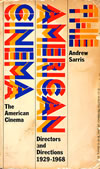Difference between revisions of "TCF112/Auteur Theory"
From Screenpedia
Jump to navigationJump to searchScreenpedia>TCFadmin (Created page with "==France, post-WW II (1945-)== *US films released in France, part of new explosion of film interest. *'''Three Godfathers of Auteur Theory''' *#Henri Langlois *#*Cinémathequ...") |
ScreenAdmin (talk | contribs) m (6 revisions imported) |
||
| (5 intermediate revisions by 2 users not shown) | |||
| Line 8: | Line 8: | ||
*#Alexandre Astruc | *#Alexandre Astruc | ||
*#*Critic | *#*Critic | ||
| − | *#*Caméra Stylo (stylus) | + | *#*''Caméra Stylo'' (stylus) |
*#*"camera pen" | *#*"camera pen" | ||
*#André Bazin | *#André Bazin | ||
| − | *#*Founder/editor of Cahiers du Cinéma | + | *#*Founder/editor of ''Cahiers du Cinéma'' |
*#*Realist theorist | *#*Realist theorist | ||
| − | *#*Nurtured young Cahiers critics who would become directors in the New Wave (Nouvelle Vague) | + | *#*Nurtured young ''Cahiers'' critics who would become directors in the New Wave (''Nouvelle Vague'') |
| − | *#**Included: Jean-Luc Godard, Eric Rohmer (edited Cahiers), François Truffaut | + | *#**Included: Jean-Luc Godard, Eric Rohmer (edited ''Cahiers''), François Truffaut |
*#*Truffaut: "A Certain Tendency in the French Cinema" (1954) | *#*Truffaut: "A Certain Tendency in the French Cinema" (1954) | ||
*#**Attacked "Tradition of Quality" | *#**Attacked "Tradition of Quality" | ||
| − | *#**Proposed "politique des auteurs" | + | *#**Proposed "''politique des auteurs''" |
*#***"policy of the authors" | *#***"policy of the authors" | ||
*#***director = auteur/author | *#***director = auteur/author | ||
| Line 23: | Line 23: | ||
*#*#Auteur | *#*#Auteur | ||
*#*#Metteur-en-scene | *#*#Metteur-en-scene | ||
| + | |||
==Auteurism in US== | ==Auteurism in US== | ||
| Line 30: | Line 31: | ||
*#Film history should be seen as a history of auteurs. | *#Film history should be seen as a history of auteurs. | ||
Films by one director should show consistencies in theme/narrative/visual style. | Films by one director should show consistencies in theme/narrative/visual style. | ||
| − | *Sarris, ''The American Cinema'' (1968) | + | *Sarris, ''''The American Cinema'''' (1968) |
| − | |||
**Index of films/directors | **Index of films/directors | ||
**Analyses of directors | **Analyses of directors | ||
| + | |||
| + | [[File:AmericanCinemaSmall.jpg]] | ||
| + | |||
==Alfred Hitchcock== | ==Alfred Hitchcock== | ||
| Line 52: | Line 55: | ||
**Promoted own image | **Promoted own image | ||
***E.g., In famous cameos | ***E.g., In famous cameos | ||
| + | |||
| + | [[Category:TCF112]] | ||
| + | [[Category:TCF112 Lecture]] | ||
Latest revision as of 21:31, 14 August 2019
France, post-WW II (1945-)
- US films released in France, part of new explosion of film interest.
- Three Godfathers of Auteur Theory
- Henri Langlois
- Cinématheque Française
- Film screenings provided film education
- Alexandre Astruc
- Critic
- Caméra Stylo (stylus)
- "camera pen"
- André Bazin
- Founder/editor of Cahiers du Cinéma
- Realist theorist
- Nurtured young Cahiers critics who would become directors in the New Wave (Nouvelle Vague)
- Included: Jean-Luc Godard, Eric Rohmer (edited Cahiers), François Truffaut
- Truffaut: "A Certain Tendency in the French Cinema" (1954)
- Attacked "Tradition of Quality"
- Proposed "politique des auteurs"
- "policy of the authors"
- director = auteur/author
- 2 types of directors
- Auteur
- Metteur-en-scene
- Henri Langlois
Auteurism in US
- Andrew Sarris, "Notes on the Auteur Theory" (1962)
- Two Principles of Auteurism
- Director = auteur of a film
- Film history should be seen as a history of auteurs.
Films by one director should show consistencies in theme/narrative/visual style.
- Sarris, 'The American Cinema' (1968)
- Index of films/directors
- Analyses of directors
Alfred Hitchcock
- Theme
- "Master of Suspense"
- Rational/order vs. Irrational/chaos
- Wrong Man
- Innocent appear guilty
- Guilty appear innocent
- Catholic guilt
- Voyeurism
- Narrative Structure
- "Wrong man" on the run, linked to a woman
- Style (visual/sound)
- Extensive use of storyboards
- High angle
- National Landmarks
- Promoted own image
- E.g., In famous cameos
